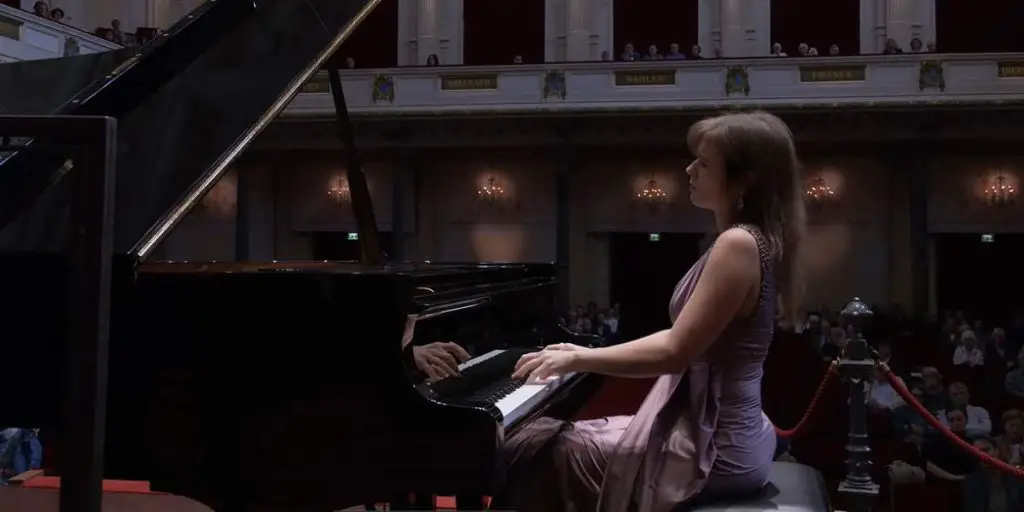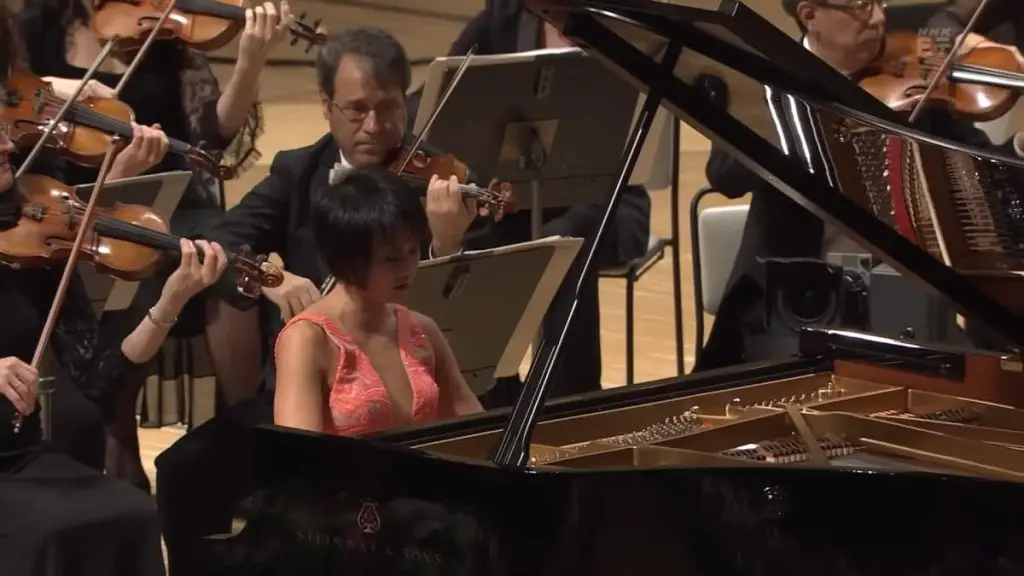Accompanied by the Orchestre National de France, the French classical pianist Alexandre Kantorow performs Frédéric Chopin’s Piano Concerto No. 2 in F minor, Op. 21. Conductor: Cristian Măcelaru. This performance was recorded on May 16, 2024, at l’Auditorium de la Maison de la Radio et de la Musique.
Frédéric Chopin’s Piano Concerto No. 2
Frédéric Chopin’s Piano Concerto No. 2 in F minor, Op. 21, is a significant work in the Romantic piano repertoire. Composed in 1829, when Chopin was just 19 years old, it was one of his early major compositions. Although it is labeled as his second piano concerto, it was actually composed before his Piano Concerto No. 1, but published after it, hence the numbering.
This concerto reflects Chopin’s deep affinity for the piano, showcasing his extraordinary skill and sensitivity as a pianist. It combines lyrical expressiveness with technical virtuosity, highlighting the piano’s capabilities and Chopin’s innovative approach to the instrument. The concerto was influenced by the styles of composers such as Johann Nepomuk Hummel and Carl Maria von Weber, yet it carries Chopin’s unique touch, characterized by intricate melodies and rich harmonies.
Chopin himself premiered the concerto in Warsaw in 1830, receiving positive acclaim. The orchestration in this concerto, as with much of Chopin’s work, serves primarily to support the piano, allowing the soloist’s part to shine prominently. The orchestral writing, while sometimes considered less complex than that of other composers, complements the piano beautifully, creating a harmonious and compelling musical dialogue.
Overall, Chopin’s Piano Concerto No. 2 remains a beloved piece in the classical music canon, admired for its poetic beauty and the way it encapsulates the Romantic spirit. It continues to be a staple in the repertoires of many concert pianists worldwide.
Movements
1. Maestoso (F minor)
The first movement of Chopin’s Piano Concerto No. 2 is marked “Maestoso.” This movement sets the stage with a grand orchestral introduction, which is typical of concertos from the Classical and early Romantic periods. The orchestra alone presents the primary themes, establishing the tonal and emotional landscape before the piano soloist enters.
Once the piano joins in, it takes center stage with a lyrical and expressive theme that showcases Chopin’s distinctive melodic style. This theme is characterized by its elegance and emotional depth, offering a stark contrast to the more forceful orchestral introduction. The piano’s role in this movement is both virtuosic and poetic, allowing the performer to display technical prowess while also conveying deep musical sensitivity.
The interplay between the piano and the orchestra in the first movement is a dialogue where the orchestra provides a supportive, sometimes dramatic backdrop to the soloist’s intricate and flowing passages. This dynamic interplay is a hallmark of Chopin’s concertos, highlighting the piano’s prominence and the orchestra’s role in enhancing the solo performance.
Chopin’s use of modulations and harmonic shifts in the first movement adds to the emotional complexity and richness of the piece. The development section explores variations on the initial themes, with the piano leading the way through virtuosic runs and elaborate passages, before returning to the recapitulation where the main themes are restated and elaborated upon.
2. Larghetto (A-flat major)
The second movement of Chopin’s Piano Concerto No. 2 is marked “Larghetto.” This movement is often regarded as one of the most beautiful and expressive slow movements in the piano concerto repertoire. It contrasts significantly with the grandeur of the first movement, presenting a more intimate and lyrical atmosphere.
This “Larghetto” opens with the piano playing a gentle and serene melody, which is reminiscent of Chopin’s Nocturnes. The music is marked by its delicate phrasing and subtle use of rubato, allowing the pianist to explore a wide range of emotional nuances. The lyrical theme introduced by the piano is then taken up and elaborated by the orchestra, creating a dialogue between the soloist and the ensemble.
The movement is notable for its dreamy and poetic quality. Chopin uses a rich harmonic palette to create a sense of longing and introspection. The piano part, with its intricate ornamentation and expressive cantabile lines, showcases Chopin’s gift for melody and his deep understanding of the piano’s capabilities. The interplay between the piano and the orchestra is particularly tender, with the orchestra often providing a soft, supportive background to the piano’s singing lines.
One of the highlights of the “Larghetto” is its middle section, where the mood shifts to a more agitated and passionate character. Here, the piano part becomes more dramatic, with rapid runs and dynamic contrasts, before returning to the serene and lyrical opening theme. This contrasting section adds depth and complexity to the movement, highlighting Chopin’s ability to convey a wide range of emotions within a single piece.
The second movement of Chopin’s Piano Concerto No. 2 is often praised for its emotional depth and lyrical beauty. It stands as a testament to Chopin’s unique voice in the Romantic era, blending technical mastery with profound expressiveness. This movement, with its tender melodies and rich harmonies, continues to captivate both performers and listeners, solidifying its place as a jewel of the piano concerto repertoire.
3. Allegro vivace (F minor – F major)
The third movement of Chopin’s Piano Concerto No. 2 is marked “Allegro vivace.” This movement is characterized by its lively, spirited, and dance-like nature, offering a vibrant conclusion to the concerto. It showcases Chopin’s deep connection to Polish folk music and his ability to infuse classical forms with a distinctly nationalistic flavor.
Opening with a brisk and energetic theme introduced by the piano, the “Allegro vivace” quickly establishes a buoyant and celebratory mood. The theme is based on the rhythms and motifs of Polish folk dances, particularly the mazurka. This folk influence brings a sense of joy and national pride to the movement, which is filled with rhythmic vitality and melodic inventiveness.
The piano part in this movement is both virtuosic and playful, featuring rapid runs, intricate passagework, and dynamic contrasts. The orchestra provides a supportive and complementary role, often echoing the piano’s themes and contributing to the overall festive atmosphere. The interplay between the soloist and the orchestra is marked by a lightness and agility that keeps the movement engaging and dynamic.
A standout feature of the “Allegro vivace” is its use of syncopation and offbeat accents, which add a rhythmic complexity and a sense of spontaneity to the music. The movement also includes a contrasting middle section, where the tempo slows down, allowing for a lyrical and expressive interlude before returning to the lively main theme.
The “Allegro vivace” concludes with a brilliant coda that brings the concerto to a rousing finish. The piano and orchestra engage in a final, exuberant dialogue, showcasing Chopin’s masterful ability to blend technical brilliance with expressive depth.
Sources
- Piano Concerto No. 2 (Chopin) on Wikipedia
- “Frédéric Chopin: Piano Concerto No.2 in F minor” on the Classic FM website
- Piano Concerto No.2, Op.21 (Chopin, Frédéric) on the International Music Score Library Project website
- “Chopin’s Piano Concerto No. 2” on My Classical Notes website



